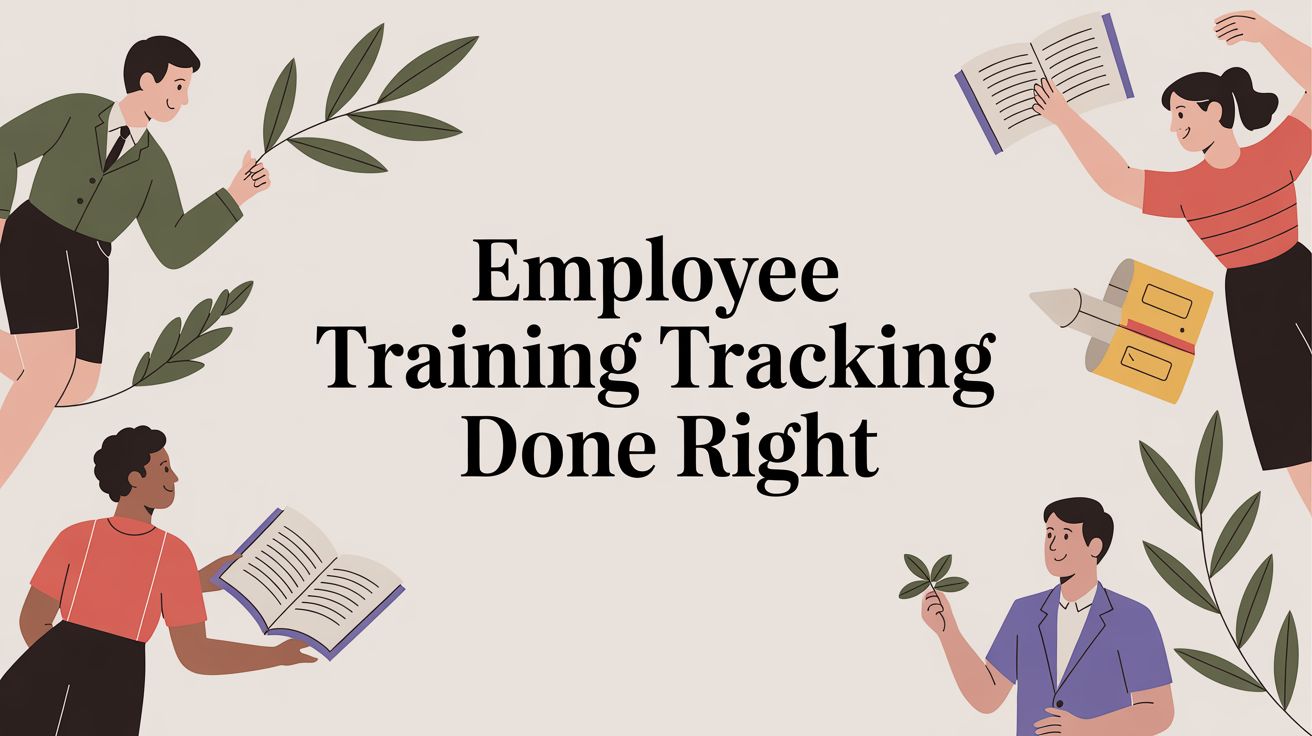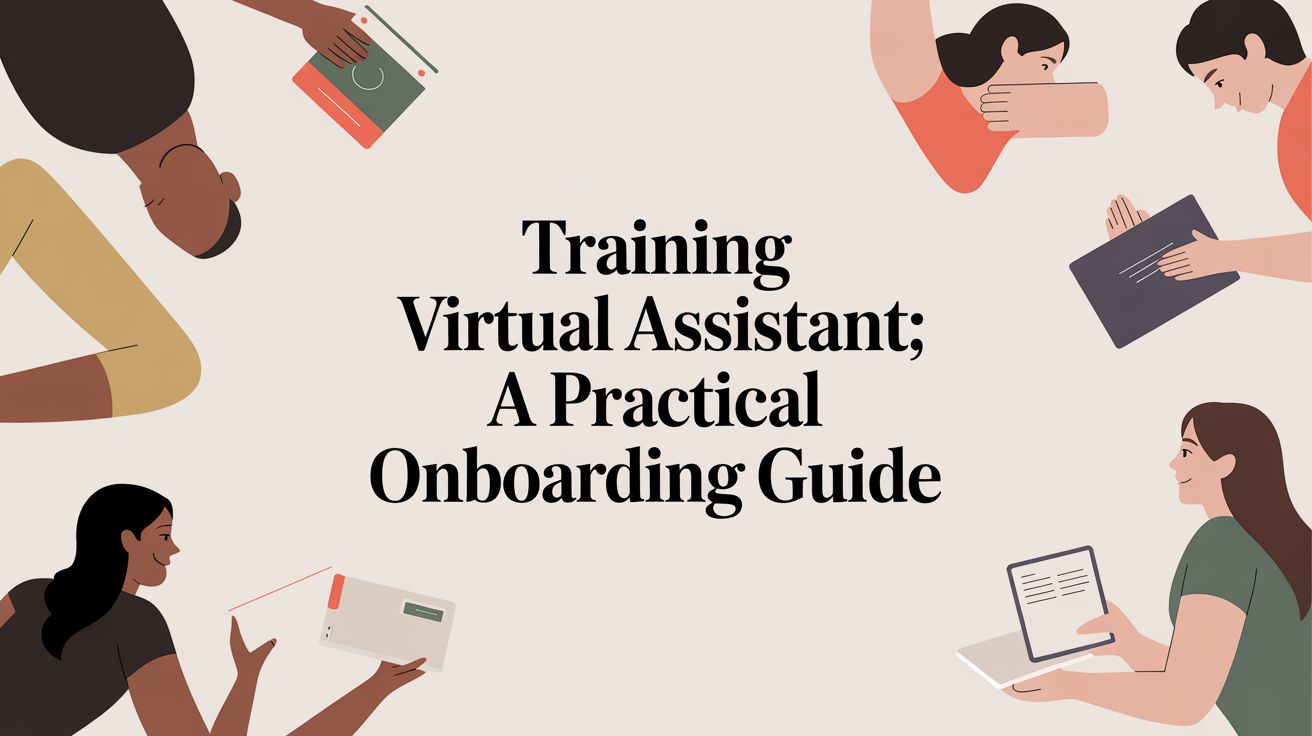Understanding CPD Accredited Meaning for Your Business

So, what does it really mean when a course is "CPD accredited"?
At its heart, it’s pretty straightforward. It means an independent, professional body has put the course under a microscope and given it a stamp of approval. This tells anyone looking to sign up that your course isn't just another workshop—it's a high-quality, structured learning experience that meets rigorous industry standards. From a business perspective, it's a powerful tool for building trust and attracting serious professionals.
What Does CPD Accredited Actually Mean?
Think of CPD accreditation like an MOT for a car. Before someone invests their time and money, that accreditation mark assures them that what’s under the hood is exactly what was advertised. It’s a powerful signal of credibility that instantly separates professional-grade training from the vast sea of other options out there. This process builds a vital triangle of trust between three key players:
- The Learner: The professional who wants to develop their skills with training they can count on.
- The Training Provider: That’s you—the organization designing and delivering the course.
- The Accrediting Body: The impartial third party that checks and confirms the quality and integrity of your course.
Building an Ecosystem of Trust
This whole system works because the accrediting body acts as an independent guarantor. They dig into your course's learning objectives, content structure, delivery methods, and how you assess learners to make sure everything is up to snuff. Getting that accreditation is more than just adding a logo to your website; it's a public commitment to excellence.
Continuing Professional Development has exploded in popularity, with formal systems now in place in over 80 countries. Many of these frameworks require activities to be accredited by official bodies to count towards a professional's license. Requirements can vary wildly, like in Armenia, where professionals need 140 credits every five years.
Pro Tip: CPD accreditation isn't for the learner; it's for the learning activity itself—the course or the training provider. It verifies the quality of the education, which in turn makes the certificate a learner earns genuinely valuable.
Grasping this distinction is fundamental to creating valuable and verifiable credentials that signify real accomplishment. It's no surprise that proper accreditation is a cornerstone of so many successful learning and development courses; it builds a foundation of trust that attracts serious professionals.
Core Components of a CPD Accredited Course
To give you a clearer picture, here's a quick look at the essential elements an accrediting body evaluates to grant a course its quality seal.
| Component | What It Signifies |
|---|---|
| Clear Learning Objectives | The course has specific, measurable goals for what a learner will achieve. |
| Structured Content | The material is logical, well-organized, and builds knowledge progressively. |
| Qualified Instructors | The people teaching the course have proven expertise in the subject matter. |
| Relevant Assessments | The methods for testing knowledge are fair, appropriate, and aligned with the objectives. |
| Sufficient Learning Hours | The course duration is realistic for covering the content and achieving the goals. |
| Learner Support | There are clear channels for learners to get help and feedback. |
Ultimately, ticking these boxes shows an accrediting body that your course is thoughtfully designed and genuinely committed to professional development.
Accreditation Versus Certification Explained
It’s incredibly common to see the terms ‘accreditation’ and ‘certification’ used interchangeably, but they represent two very different sides of the same coin. Getting this distinction right is key to understanding what being CPD accredited truly means.
Put simply, accreditation applies to the training provider or the course itself. In contrast, certification is what the individual earns after they’ve successfully finished that course.
A good analogy is a university. The entire university works hard to earn its accreditation, which is a stamp of approval showing it meets high academic standards. Once a student completes their studies and graduates, they receive a certificate (or degree). The value of that student's certificate is directly linked back to the university’s accredited status.
The Relationship Between Quality and Recognition
The same principle holds true in professional development. A CPD certificate’s credibility is built on the foundation of the course’s accreditation. Without that independent, third-party endorsement, a certificate is just a document. With accreditation backing it up, it becomes a powerful signal of real learning and validated skills.
Key Distinction: Accreditation is the quality assurance review of the training program, confirming its content and structure are sound. Certification is the proof of achievement awarded to the learner.
This dynamic is vital for any training provider to grasp. Professionals actively look for accredited courses because they know the certificate they earn will be recognized by employers, professional bodies, and industry peers. This is especially true for competency-based training, where accreditation confirms that the skills being taught meet genuine industry benchmarks.
Ultimately, your goal as a provider is to offer training where the course's accreditation gives undeniable weight and value to the certificate a delegate walks away with. This creates a powerful draw for serious learners and boosts your credibility in the market.
The Business Case for CPD Accreditation
Getting your courses accredited might feel like just another box to tick, but it’s one of the smartest business moves you can make. It’s not just an administrative hoop to jump through; it's a strategic decision that builds trust, fuels growth, and cements your place in the market. For professionals looking to upskill, that accreditation stamp is an instant signal of quality. It tells them your training is respected, recognized, and worth their time and money.
For your training business, this is where cpd accredited meaning translates directly into a competitive edge. Think of accreditation as a trusted third-party endorsement. It immediately sets you apart from the sea of non-accredited competitors and gives you the credibility to justify premium pricing. When clients see that seal of approval, they know they’re paying for a guaranteed standard of excellence.
Attracting High-Value Corporate Clients
This distinction becomes even more critical when you're aiming for corporate clients. Most large companies have dedicated training budgets and procurement policies that don’t just prefer accredited training—they often require it. Having that accredited status gets your foot in the door for larger, more lucrative contracts that would otherwise be out of reach. You become a pre-vetted, trusted option.
It also works wonders for attracting top talent to your team. The best instructors want to work with providers who are serious about quality. Your accreditation signals a level of professionalism that makes it far easier to bring in and keep expert trainers, which only elevates your course delivery and reputation even further.
Business Impact: Accreditation is more than a badge; it's a key that unlocks access to corporate clients, justifies higher course fees, and attracts top talent, turning a quality standard into a core component of your growth strategy.
Driving Retention and Verifying Quality
The demand for quality professional development isn't just anecdotal—the numbers back it up. A massive 94% of Fortune 500 companies rely on professional accreditation and CPD programs to develop their employees. What's more, organizations with strong CPD frameworks often see employee retention rates up to 57% higher than those without. This shows that accreditation directly meets a critical business need for companies focused on keeping their best people. You can dig deeper into these findings in this report on CPD accreditation.
When you make accreditation a cornerstone of your business strategy, it stops being a simple compliance task and becomes a powerful engine for development, marketing, and sales. It’s a clear statement that your training delivers real, measurable value, making it an easy choice for both discerning professionals and corporate decision-makers.
Navigating the Path to Accreditation
Getting your training course CPD accredited might seem daunting, but it’s really just a methodical process. Think of it less as a mystery and more as a journey that starts with smart preparation. Your first move is to find an accrediting body that genuinely fits your industry and what your learners need. Not all bodies are the same; they often have different specialities, so finding the right match is key.
With the right body chosen, your attention turns to the application itself. This is where the details really matter. Assessors are working from a specific checklist, looking for clear signs of quality and professionalism in every document you submit.
What Assessors Look For
To give your application the best chance of success, you'll need to have solid documentation covering a few core areas. Each piece of the puzzle helps build a picture of a course that meets the high standards they expect.
- Clearly Defined Learning Objectives: Spell out exactly what someone will be able to do or understand once they’ve finished your course. No vague promises.
- Structured Session Plans: Show them the roadmap. Your course outline needs to demonstrate a logical flow that takes learners from A to B.
- Robust Assessment Methods: How will you know if they’ve learned anything? Detail your approach, whether it's through quizzes, hands-on exercises, or a final exam.
- Trainer Qualifications: Who is leading the training? Provide CVs or detailed bios that showcase your instructors' expertise and credentials in the subject.
Pro Tip: Don’t just list what your course includes. Explain the why behind your choices. Connect your content decisions and assessment strategies directly back to those learning objectives you defined. It shows you’ve put real thought into the course design.
Meeting these kinds of standards has become even more important over time. The first global standards for CPD appeared back in 2003, and they've since been updated to be more flexible. Even so, only about 30% of countries have official systems to measure the actual impact of CPD, which is why a trusted third-party accreditation carries so much weight. You can read more on how CPD standards have evolved globally.
When you align your training with these benchmarks, it doesn't just make the review process smoother—it elevates your entire offering. While many providers use e-learning platforms for asynchronous learning, managing instructor-led sessions requires a specific set of tools, as we cover in our guide to the best LMS for corporate training. At the end of the day, a successful application is your proof that the course delivers a credible and valuable learning experience.
Managing Accredited Courses Without the Headaches
Earning that CPD accreditation is a fantastic achievement, but it’s also the starting line for a whole new set of responsibilities. Suddenly, you're on the hook for keeping flawless records, tracking every single delegate's progress, and issuing perfectly formatted, compliant certificates. For a growing training business, this administrative burden can quickly turn from a small task into a major headache.
This is exactly where the right technology steps in. A purpose-built training management system (TMS), designed specifically for instructor-led live, face-to-face, or hybrid training, isn't just a nice-to-have; it's essential. It helps you ditch the clunky spreadsheets and scattered documents for a single, central hub to manage all the complexities that come with being an accredited provider.
Automating the Essentials of Compliance
Picture this: the moment a course finishes, a CPD-compliant certificate is automatically generated and sent to each delegate, complete with all the necessary details. No more manual data entry or double-checking names. A good training management system like Coursebricks handles these crucial tasks for you, saving a massive amount of time and eliminating human error.
When it's time for an audit, you can pull up a detailed report on delegate attendance and completion in just a few clicks. The accrediting body gets what they need, and you look like the professional you are.
But it’s not just about certificates. The right system can automate so much more to protect your accredited status:
- Centralised Delegate Records: Every learner's history—from their first enquiry to their final certificate—is stored securely in one place.
- Automated Communications: Forget manually sending reminders or follow-up materials. The system can handle confirmations, pre-course information, and feedback requests automatically.
- Integrated Booking & Payments: You can offer a smooth, professional enrolment experience from start to finish, which reflects well on your brand.
Key Takeaway: A training management system isn't just an efficiency tool; it's a risk management system. It safeguards your hard-won accreditation by ensuring your back-office processes are as professional and compliant as the training you deliver.
Of course, to deliver truly high-quality CPD, you also need to build your courses using modern instructional design best practices. A TMS frees up your time to do just that.
When you automate the admin, you can get back to what you do best: creating and delivering exceptional learning experiences. You're no longer buried in paperwork but empowered to scale your business with confidence. Strong systems for employee training tracking are the bedrock of this, giving you the data to prove compliance and measure the real-world impact of your courses.
What's the Next Step on Your Accreditation Journey?
So, we've walked through what CPD accredited meaning actually stands for in the real world. We've seen why it’s so valuable for your business and laid out the roadmap to get there.
Earning that accreditation isn't just about ticking a box. It’s a powerful signal to the world that you're serious about quality and committed to delivering real, verifiable value. It’s a strategic move that builds trust and sets you apart from the crowd.
Once you have that seal of approval, the real work begins: managing it all effectively. Juggling the compliance, tracking, and certification for accredited instructor-led training can quickly become a huge administrative headache if you're relying on spreadsheets and manual processes.
Final Takeaway: Your credibility hinges on two things: the quality of your courses and the professionalism of your operations. Don't let clunky admin work tarnish the reputation you've worked so hard to build.
This is where having the right tools in your corner makes all the difference. A dedicated training management system can automate the heavy lifting, freeing you up to focus on what you actually love to do—creating and delivering incredible training.
If you're ready to see how a purpose-built platform can help, take a look at what Coursebricks can do. It's designed to help you automate compliance, simplify your day-to-day operations, and grow your business without the administrative burnout.
A Few Common Questions About CPD Accreditation
Getting to grips with professional development often raises a few questions. Let's clear up some of the most common ones we hear from training providers about what CPD accreditation really means and how it all works.
Is CPD Accreditation Recognised Internationally?
Absolutely. CPD is a well-respected concept around the globe, and its accreditation carries weight in many countries, including the UK, Canada, and throughout Europe.
That said, the specifics can differ from one industry or country to the next. A professional body in one region might have slightly different standards than another, so it’s always a good idea to check with the relevant authorities where you plan to operate.
What's the Difference Between CPD and RQF?
This is a great question. Think of it this way: CPD accreditation is all about validating the quality of shorter, ongoing learning activities—like workshops, webinars, or online courses. It confirms the training is well-structured and valuable for professional growth.
The RQF (Regulated Qualifications Framework), on the other hand, is the system for formal, nationally recognised qualifications in the UK. We're talking about things like a Level 3 Diploma, which sits at a specific, government-regulated academic level.
The Bottom Line: CPD is a quality stamp for continuous skills development, while RQF is a formal grade for qualifications that fit into the national education system.
Can Any Training Course Become CPD Accredited?
In principle, yes—as long as it hits the high standards set by the accrediting body. It’s not really about the subject matter. It's about the quality behind it.
To get the green light, your course needs to show it has:
- Clear learning objectives
- Well-structured content
- Qualified instructors
- A fair way of assessing learners
Ultimately, it all comes down to the integrity of your course design and how effectively it’s delivered.
Ready to explore Coursebricks?
Manage training programs, automate emails, and generate detailed reports — all in one place.


























